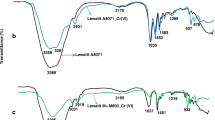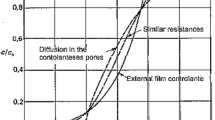Abstract
An experimental breakthrough curve for Salicylic acid in an adsorption recovery process was determined by an anion-exchange resin IRA-93. The volumetric mass transfer coefficients were calculated by employing constant wave propagation theory. Meanwhile, the effects of volumetric feed flow rates on this break through curve and mass transfer coefficients at different flow rates were also studied in order to develop three new models to predict mass transfer coefficient. The results demonstrated that by the increase in the feed flow rates, the amount of adsorption reduces. However, while the volumetric feed flow rates increase the overall volumetric mass transfer coefficients will increase. This grows the feeling that the feed flow rate should be optimized. The optimum flow rate for the adsorption was found to be 7 mg/l in this study. In addition, three new models to predict the mass transfer coefficient in respect of feed rates were developed in this research work which showed very high fittings with R2>0.99. These models could fully support the experimental data obtained.
Similar content being viewed by others
References
M. Otero, M. Zabkova and A. E. Rodrigues, Sep. Purif. Technol., 45, 86 (2005).
K. Kunin, Pure Appl. Chem., 46, 205 (1976).
A. Morão, A. Lopes, M. T. Pessoa de Amorim and I. C. Gonçalves, Electrochim. Acta., 49, 1587 (2004).
W. Kujawski, A. Warszawski, W. Ratajczak, T. Porebski, W. Capala and I. Ostrowska, Sep. Purif. Technol., 40, 123 (2004).
S.H. Lin, C. L. Pan and H.G. Leu, Chem. Eng. J., 87, 163 (2002).
S. P. Deosarkar and V. G. Pangarkar, Sep. Purif. Technol., 38, 241 (2004).
E.H. Crook, R. P. McDonell and J. T. McNulty, Ind. Eng. Chem. Prod. Res. Dev., 14, 113 (1975).
D. S. Farrier, A. L. Hines and S. E. Wang, J. Colloid Interface Sci., 69, 233 (1979).
G. M. Gusler, T. E. Browne and Y. Cohen, Ind. Eng. Chem. Res., 32, 2727 (1993).
D. Hanesian and A. J. Perna, The sitting, process analysis and design of a manufacturing facility using hazardous material in a residential community (The manufacture of aspirin), Workbook, New Jersey Institute of Technology, Newark, New Jersey (1999).
C.G. Daughton and T.A. Ternes, Environ. Health Perspect., 107, 907 (1999).
E. Erikson, K. Auffarth, A.-M. Eilersen, M. Henze and A. Ledin, Water SA., 29 (2003).
X. T. Li, B. C. Pan and F.W. Meng, Ion. Exch. Adsorpt., 21, 209 (2005).
D. Chatzopoulos and A. Varma, Chem. Eng. Sci., 50, 127 (1995).
A. Wolborska and P. Pustelnik, Water Res., 30, 2643 (1996).
A. J. Slaney and R. Bhamidimarri, Water Sci. Technol., 38, 227 (1998).
A. Wolborska, Chem. Eng. J., 73, 85 (1999).
J.M. Chern and Y.W. Chien, Water Res., 36, 647 (2002).
B. C. Pan, Y. Xiong and A. M. Li, React. Funct. Polym., 53, 63 (2002).
B. Salamatinia, A.H. Kamaruddin and A. Z. Abdullah, Chem. Eng. J., 145, 259 (2008).
S. Takac, G. Calik, M. Aytar and T.H. Ozdamar, Biochem. Eng. J., 2, 101 (1998).
J. J. Carberry, Chemical and catalytic reaction engineering, McGraw-Hill (1976).
D. Chatzopoulos and A. Varma, Chem. Eng. Sci., 50, 127 (1995).
A. Wolborska and P. Pustelnik, Water Res., 30, 2643 (1996).
A. J. Slaney and R. Bhamidimarri, Water Sci. Technol., 38, 227 (1998).
A. Wolborska, Chem. Eng. J., 73, 85 (1999).
Author information
Authors and Affiliations
Corresponding author
Rights and permissions
About this article
Cite this article
Kananpanah, S., Dizadji, N., Abolghasemi, H. et al. Developing a new model to predict mass transfer coefficient of salicylic acid adsorption onto IRA-93: Experimental and modeling. Korean J. Chem. Eng. 26, 1208–1212 (2009). https://doi.org/10.1007/s11814-009-0215-6
Received:
Accepted:
Published:
Issue Date:
DOI: https://doi.org/10.1007/s11814-009-0215-6




